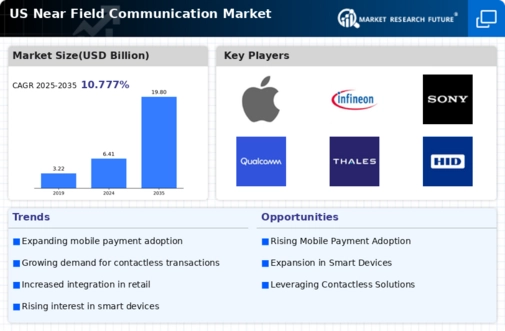Market Growth Chart
The Global US Near Field Communication Market Industry is poised for substantial growth, as illustrated in the accompanying chart. The market is expected to reach 25 USD Billion in 2024, with projections indicating a rise to 75 USD Billion by 2035. This growth trajectory reflects a compound annual growth rate of 10.5% from 2025 to 2035, highlighting the increasing adoption of NFC technology across various sectors.
Growing Demand for Smart City Solutions
The Global US Near Field Communication Market Industry is significantly influenced by the increasing demand for smart city solutions. Urban areas are adopting NFC technology to enhance public services, improve transportation systems, and streamline urban management. For instance, NFC-enabled public transport systems allow for efficient fare collection and real-time tracking. As cities invest in smart infrastructure, the market is poised for growth, with projections indicating a market size of 75 USD Billion by 2035. This trend reflects a broader shift towards digitization and connectivity in urban environments, potentially leading to a CAGR of 10.5% from 2025 to 2035.
Rising Adoption of Contactless Payments
The Global US Near Field Communication Market Industry experiences a notable surge in the adoption of contactless payment solutions. As consumers increasingly favor convenience and speed, businesses are integrating NFC technology into their payment systems. In 2024, the market is projected to reach 25 USD Billion, driven by the growing preference for mobile wallets and contactless cards. Retailers and service providers are investing in NFC-enabled terminals, enhancing customer experiences. This trend is expected to continue, with projections indicating a market size of 75 USD Billion by 2035, reflecting a robust CAGR of 10.5% from 2025 to 2035.
Technological Advancements in NFC Devices
Technological innovations play a pivotal role in propelling the Global US Near Field Communication Market Industry forward. The continuous enhancement of NFC-enabled devices, including smartphones, wearables, and IoT gadgets, facilitates seamless communication and data transfer. Manufacturers are focusing on improving security features, such as encryption and authentication, to bolster consumer confidence. As these advancements become more mainstream, the market is likely to witness increased adoption across various sectors, including retail, healthcare, and transportation. The integration of NFC technology into everyday devices is expected to drive market growth significantly in the coming years.
Enhanced Security Features in NFC Transactions
Security concerns surrounding digital transactions are driving innovations in the Global US Near Field Communication Market Industry. Enhanced security features, such as tokenization and biometric authentication, are being integrated into NFC systems to protect sensitive consumer data. As businesses and consumers prioritize secure payment methods, the demand for NFC technology is likely to increase. This focus on security not only fosters consumer trust but also encourages wider adoption across various sectors, including finance and retail. The market's growth trajectory is supported by the anticipated rise to 75 USD Billion by 2035, with a CAGR of 10.5% from 2025 to 2035.













Leave a Comment